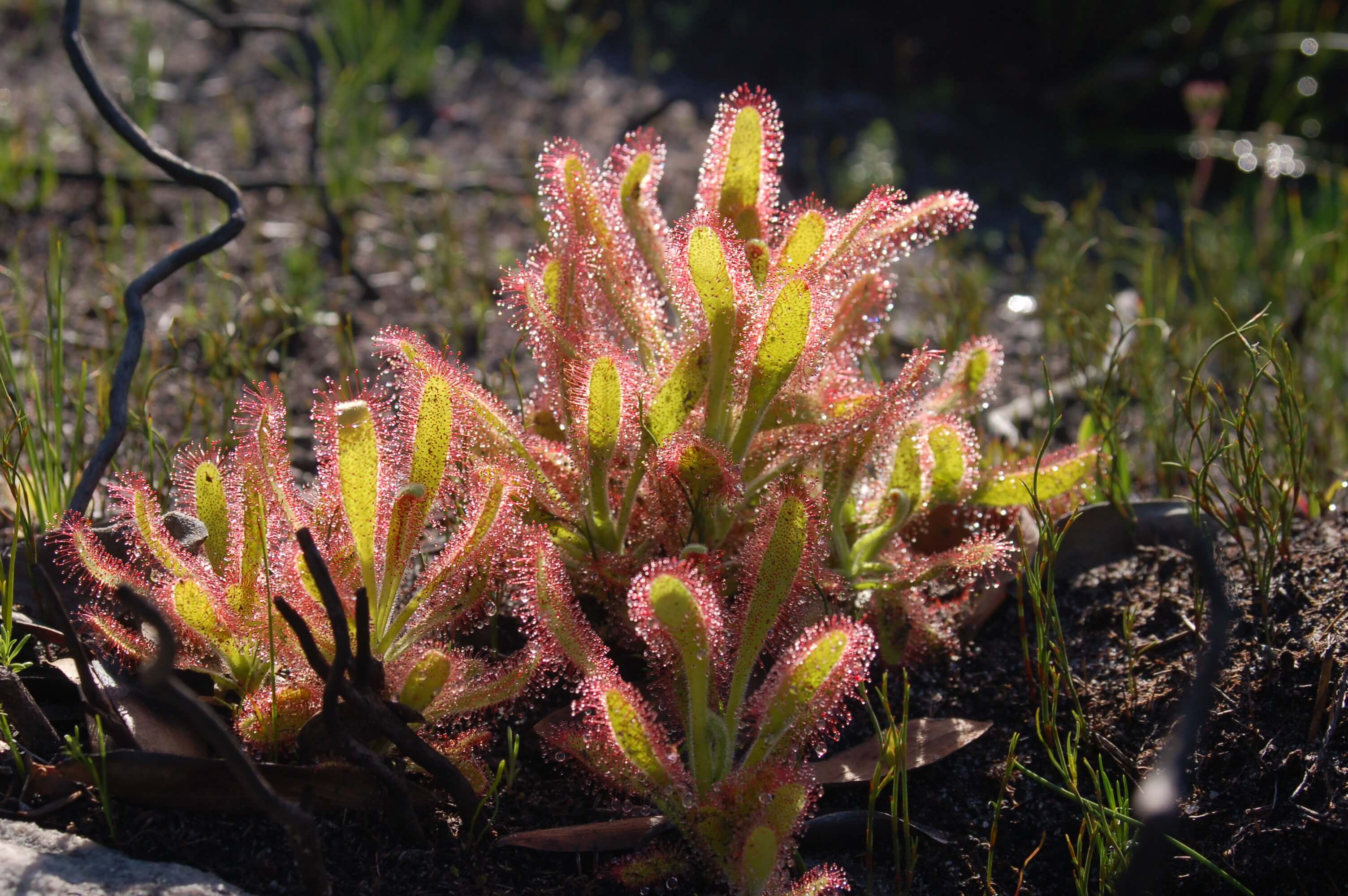Forget what you learnt at school: the science of Botany has been re-written – by none other than yours truly – and I present, after many years of diligent observation, Chadbon’s Three Immutable Laws of Fynbos.
Law 1. Afrikaans has Better Names for Plants than English
It’s true: it may be called a Sun Dew in English, with its sticky, glue-tipped hairs quivering in the sunlight, but it’s a Snot Rose in the Afrikaans language. And something as obvious as a Confetti Bush – you know, lots of little white flowers – changes its character completely when you learn its name in Afrikaans is Aasbos – pronounced uncomfortably as Arse Boss. (The good news is that the plant’s leaves smell very pleasant when crushed – lemony-soapy – and were used to rid a fisherman’s hands of the foul odour and slime of aas – fishing bait.)

The carnivorous Sun Dew uses its sticky tentacles to catch its insect prey, earning it the name Snot Rose in Afrikaans.
And it’s not as if the Afrikaans names are better because they are short and earthy. Take Gnidia squarrosa for example: its yellow-orange flowers inspired some genius in an English laboratory to call it a Saffron Bush but because it releases its scent at night (moths pollinate it) it is known as a Juffertjie-Roer-by-die-Nag in Afrikaans, which translates as ‘Young Lady Who Gads About by Night’. Or what about the prickly Muraltia heisteria? It’s a Butterfly Bush in English (yawn) but a ‘Bird-Don’t-Sit-on-Me-Bush’ in Afrikaans. I mean really, I couldn’t make this up.

The delicate leaves & flowers of the Confetti Bush belie its cleaning properties; a much-favoured bush for anglers with smelly hands to clean.

This Lobostemon takes its English name from the scientific one but it’s called Agtdaeggeneesbos in Afrikaans – an Eight-Day-Healing-Bush.
Law 2. If in Doubt, it’s a Daisy
Picture the scene: I’ve just been asked to identify a non-descript shrub with small dry leaves and no flowers. Or a strange plant I’ve not seen before, perhaps a fat-leaved thing lounging over a sand dune. Chances are you’re going to hear this phrase:
“I’m pretty sure it’s a daisy of some kind.”
With well over 20 000 species worldwide and with 1 000 different types found in fynbos, the Asteraceae (daisy) family is the world’s largest (though Orchid aficionados may take issue with me). And forget the idea of little yellow and white flowers peeping out of your lawn. Daisies in the fynbos can be huge shrubs or sprawling cactus-like succulents; their leaves can look like ferns and they flower in purple, crimson-red and shining silver as well as the more familiar yellow and orange.

It should be pretty obvious this yellow dazzler is a daisy …
There is some relief: when the plant is in flower, it is usually instantly recognisable as a daisy – you know, that classic image we all draw when asked to draw a flower. But even when they are in flower, there are so many different species that they all become a bit of a fuzz. Bird watchers talk ruefully about ‘LBJs’ – Little Brown Jobs (small, brown, hard to identify birds); well, in the fynbos we talk about an AYD – Another Yellow Daisy. It’s not rigorous science but it’s close enough.

But not so much with this one; it is also known as Bushman’s Tea & makes a pretty awful cuppa.
Law 3. If it has a Smell, We Use it as Well
Take a ten minute stroll through fynbos, randomly crushing the leaves of plants as you go (careful of the blister bush) and you will be overwhelmed by the scents on your fingers: rosemary, liquorice, antiseptic and urine – it’s all there.

The strong-smelling leaves of the Kruidjie-Roer-my-Nie (Touch-me-Not) were used to treat sores, ringworm & bruises as well as haemorrhoids & burns.
Smelly leaves are different to smelly flowers. Flowers emit a scent to attract pollinating insects; many leaves, on the other hand, are loaded with pungent, toxic chemicals to prevent them from being eaten – you can feel greasy oils on your fingers as you rub the leaves. It might smell like something you’d like to wear as a perfume, but to a hungry caterpillar or antelope, it tastes like poison.

Feeling a bit bilious? Make a cup of tea with the hospital-like smelling leaves of Brown Salvia & enjoy relief from indigestion & flatulence.
But humans don’t seem to mind these chemicals. In fact, you may even be benefitting from a toxic-laden fynbos plant yourself – perhaps even as you read this – if you drink Rooibos tea. The Dettol-like smell of one plant (a daisy, of course) perhaps encouraged its use as an antiseptic; the stunning mango-strawberry scent of the Kukumakranka fruit made it a popular air-freshener in the old days, and the powerful citrus-eucalyptus smell of Buchu leaves meant that they ended up in a bottle of brandy to create a healing tonic. (It works if you drink enough of it, I was once told.)

The delicate flowers of a China Flower – rub the leaves & you smell lemon: it’s one of the Buchus, used for medicinal purposes even today – including by your writer!
Incidentally, the last two plant names – Kukumakranka and Buchu – are not Afrikaans but belong to a long-forgotten Khoisan language, a reminder that our interaction with such plants goes back hundreds of thousands of years. The Khoisan – a diverse ethnic group that included the Bushmen – once wandered the unspoilt slopes of Table Mountain, using the fynbos as their supermarket and pharmacy. This was at a time when the roar of lions and the aggrieved snort of a rhino rang out over what is now Cape Town. But that’s a story for another time.
